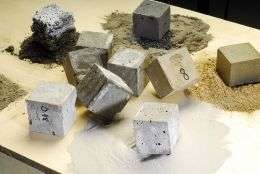Strong, lightweight green material could replace concrete, but contains no cement

(PhysOrg.com) -- Each year, coal-burning power plants, steel factories and similar facilities in the United States produce more than 125 million tons of waste, much of it fly ash and bottom ash left over from combustion. Mulalo Doyoyo has plans for that material.
An assistant professor in Georgia Tech’s School of Civil and Environmental Engineering, Doyoyo has developed a new structural material based on these leftovers from coal burning. Known as Cenocell, the material offers attributes that include high strength and light weight – without the use of cement, an essential ingredient of conventional concrete.
With broad potential applications and advantages such as good insulating properties and fire resistance, the “green” material could replace concrete, wood and other materials in a broad range of applications in construction, transportation and even aerospace.
“Dealing with the ash left over from burning coal is a problem all over the world,” said Doyoyo. “By using it for real applications, our process can make the ash a useful commodity instead of a waste product. It could also create new industry and new jobs in parts of the world that need them badly.”
Fly ash is composed of small particles removed from combustion gases by pollution control systems. Most of it must now be disposed of as a waste product, though certain types of fly ash can be used to replace a portion of the cement used in conventional concrete.
Cenocell, produced from either fly ash or bottom ash in a reaction with organic chemicals, requires none of the cement or aggregate – sand and rock – used in concrete. And unlike concrete, it emerges from curing ovens in final form and does not require a lengthy period to reach full strength.
“This is a new material very different from concrete,” Doyoyo said.
Because it uses what is now considered a waste material to replace cement – which generates carbon dioxide, a greenhouse gas – the new material is considered an asset to the environment. The material can have a wide range of properties that make it competitive with concrete, especially the new classes of autoclaved lightweight concrete.
For instance, specific densities range from 0.3 to 1.6, and the material can be manufactured to withstand pressures of up to 7,000 pounds per cubic inch. The properties can be controlled by choosing the proper ash particles size, chemical composition, and the curing time, which can range from three to 24 hours.
“We have a wide range in terms of texture, properties, performance and applications,” said Doyoyo. “The possibilities for this material are very broad.”
Among the potential applications for the material are:
-- Building and construction industry – infrastructure materials that provide sound, crash and fire barriers; permeable pavements; drainage fillers; ultra-light truss stiffeners, foam, wood and concrete replacements in residential and commercial buildings; and acoustical tiles. Cenocell is lighter than most “lightweight” concrete, and lightweight versions can be machined and cut with standard band saws.
-- Transportation industry – cores for shock and crash absorbers; fillers for trailer floors or b-pillars in vehicle frames.
-- Aerospace industry – ultra-light heat shielding.
-- Protective installations – fireproof blast walls or structural fillers for hazardous fluids.
Though for competitive reasons he won’t disclose the precise chemical composition of Cenocell, Doyoyo says the processing involves mixing the ash with organic chemicals. The chemical reaction produces foaming, and results in a gray slurry that resembles bread dough. The material is then placed in forms and cured in ovens at approximately 100 degrees Celsius until the desired strength is attained.
“We form a final compound through a combination of chemical and mechanical processes,” Doyoyo explained. “Once it comes out of our process, it is ready to go and does not continue to change over time.”
Unlike concrete, which remains a mixture of materials held together by chemical bonds, Cenocell is a homogenous material. The cell sizes and final strength depend on both the curing time and size of the ash particles used. Estimates suggest the material could be manufactured for an average cost of $50 per cubic yard.
Doyoyo and his research team – which also includes Paul Biju-Duvall, Julien Claus, Dereck Major, Rolan Duvvury and Josh Gresham – have so far made only small samples for testing. They are working with a Georgia-based maker of autoclaved concrete to produce larger samples for additional testing. Large-scale manufacturing could be done with the same equipment now used to make autoclaved concrete, he says.
Doyoyo will present information about the material at the inception workshop of the Resource-Driven Technology Concept Center in South Africa (RETECZA) December 1-3, 2008, and at the World of Coal Ash meeting May 4-7, 2009.
“We are focusing a lot on the construction industry,” Doyoyo said. “When this material is used to build a structure, it will save a lot of energy for heating and air conditioning because of its good insulating properties.”
A native of South Africa who was educated at the University of Cape Town, Brown University and Massachusetts Institute of Technology, Doyoyo sees value beyond the re-use of a waste material. He believes Cenocell could provide low-cost housing in developing countries and economic development impact from a new industry.
“This material could help develop communities by allowing people living near coal-burning facilities to create a new industry and new jobs,” he said. “This could be an engine of development for people who have been struggling. It really is a material with a social conscience.”
Provided by Georgia Institute of Technology





















